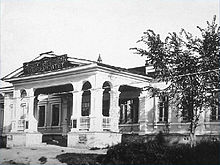Al-Farabi Kazakh National University
Әл-Фараби атындағы Қазақ Ұлттық Университеті Казахский национальный университет имени аль-Фараби | |
 | |
| Type | National |
|---|---|
| Established | 1934 |
| Rector | Mutanov Galimkair Mutanovich |
| Students | 20,000 |
| Undergraduates | 16,000 |
| Postgraduates | 4,000 |
| Address | Al-Farabi Avenue, 71 , , |
| Campus | urban |
| Website | http://www.kaznu.kz/ |
Al-Farabi Kazakh National University (Template:Lang-kz, Template:Lang-ru), also called KazGU or KazNU, is a university in Almaty, Kazakhstan. Named after the Muslim scholar al-Farabi, it is the country's primary and largest university.
KazNU is the oldest classical university of the Republic established by the Decree of the Kazakh Regional Committee (KRC) office dated November 13, 1933. One year after Kazakhstan's 1990 declaration of independence, the name was changed to Al-Farabi Kazakh State University. In 2001, the government classified it as a "national" university. More than 20000 students, graduates and PhD students study at KazNU, and there are more than 2500 faculty members working at KazNU, including 400 doctors of science, professors and more than 800 candidates of science and associate professors. Like other universities founded under the Soviet system, it is highly centralized.[clarification needed]
Campus
The University has its own campus, the so-called "Kazgugrad", on the land between Timiryazev Street, Al-Farabi Avenue, the "Yessentai" ("Vesnovka") river, and the Botanical Garden. The main building (GUK) is 15 storey tall and hosts the administration and the History, Economics, Law, Philology and Journalism faculties. Al-Farabi Kazakh National University has the largest campus in Kazakhstan with a total area of 100 hectares in one of the most beautiful places of Almaty. The education infrastructure of the campus consists of 13 education buildings with a total area of 165 000 m² and scientific laboratories with a total area of 18 940 m².
There are 10 dormitories on campus and three more faculties: Geography, Biology, Preparatory and International Relations.
The departments of Physics, Mechanics-Mathematics, Chemistry were primarily located in the city. But in 2011 they moved to the newly constructed buildings on campus.
History

January 15, 1934 is the day of the official opening of Kazakh State University, which was established at the basis of the Pedagogical Institute by the decree of the Council of Peoples’ Commissars of USSR and VKPb Kazakh regional committee. On December 2 of the same year KazSU was named after the famous Soviet party and state leader S.M. Kirov.
In January 1934, the first entrance exams at the faculties of Biology, Physics and Mathematics were held; in September they were held at the Faculty of Chemistry. In 1937, the first Faculty of Humanities – the Faculty of Foreign Languages was established; a year later, the Faculty of Philology. In May 1941, as a result of joining with the University of the Kazakh Communist Institute of Journalism, the Faculty of Journalism was established.
After the severe years of war, new faculties began to open. In August 1947, the Faculty of Geography was established and, in 1949, the faculties of Philosophy and Economics. As a result of the joining with the Alma-Ata Institute of Law in 1955, the Faculty of Law was established.
During the same period a strong scientific educational and methodological base emerged at the university. By the mid-1980s there were 98 departments, 43 scientific research laboratories and 9 scientific research groups at KazSU. The faculty staff consisted of 1180 people; among the faculty staff there were 30 academicians and AS KazSSR correspondent members, more than 100 doctors, professors, more than 600 science candidates, lecturers. Human resources were trained on 21 specialties and 74 specializations.
Faculties
- Faculty of Mechanics and Mathematics
- Physics Faculty
- Biology Faculty
- Chemistry Faculty
- Geography Faculty
- History Faculty
- Philology Faculty
- Faculty of Journalism
- Faculty of International Relations
- Oriental Studies Faculty
- Faculty of Political Science and Philosophy
- High school of economics and business
- Law Faculty
- Preparatory Faculty for Foreign Students
Partner universities
 Hankuk University of Foreign Studies, Republic of Korea
Hankuk University of Foreign Studies, Republic of Korea Pusan University of Foreign Studies, Republic of Korea
Pusan University of Foreign Studies, Republic of Korea Soongsil University, Republic of Korea
Soongsil University, Republic of Korea Ching Yun University, Taiwan
Ching Yun University, Taiwan
Notable alumni
- Gulzhana Karagusova, Kazakhstan's Minister of Social Justice
- German Kim, head of the Department of Korean Studies and one of the leading internationally recognised scholars of the Koryo-saram
- Oleg Novachuk, Kazakh businessman, currently Chief Executive of Kazakhmys
- Zhanseit Tuimebayev, Kazakhstan's former Minister of Education and former ambassador to Russia
- Igor Rogov, head of the Constitutional Council
- Mukhtar Magauin, Kazakh writer and publicist
- Yessengaly Raushanov, Kazakh writer and poet.
- Bakhytzhan Zhumagulov, Kazakhstan's Minister of Education
- Tauman Torekhanov, Kazakh journalist, editor and writer
- Kanat Auyesbay, Kazakh newsreader
- Oralkhan Bokeev, Kazakh writer
